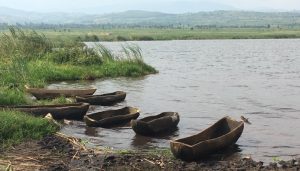35 Sub-Saharan Africa:
Cultural Geography II –
Peacemaking in Burundi: The Institution of the Bashingantahe
As written by Professor Elizabeth McClintock and Térence Nahimana
Geography
The Republic of Burundi is a tiny, landlocked country in Central Africa, wedged between the Democratic Republic of Congo (DRC) to its west, Tanzania on its southern and eastern borders, and Rwanda to the north. The country has a surface area of 27,830 square kilometers, (slightly smaller than the U.S. state of Maryland) and sits on the northeastern shores of Lake Tanganyika. Burundi has a population of approximately 12,500,000, making it one of the most densely populated countries in the world with 463 inhabitants per square kilometer. Burundi’s ethnic make-up is approximately 85% Hutu; 14% Tutsi; and 1% Twa. A challenge for the assessment of life in Burundi, these statistics have been cited to describe the ethnic make-up of Burundi for over 50 years. They are impossible to verify as no official census has been taken since independence. Despite being a minority, the Tutsi dominated social, political, and economic relations for over 40 years following Burundi’s independence.
In addition, children of mixed marriages are identified by their father’s ethnicity and, since independence, a fourth “ethnic” category, the Ganwa, have slowly disappeared as a category of Burundians (gradually subsumed into the Tutsi “ethnicity,” as the monarchy becomes a distant memory), making it difficult to accurately determine the percentages of Hutu and Tutsi among Burundians, were it even politically possible to do so.

Photo by Elizabeth McClintock
Over 90% of Burundians rely on subsistence farming or the informal economy, making land a coveted resource which has only grown in value – and as a source of conflict – as population density has increased. Burundi’s economy is predominantly agricultural, with agriculture accounting for over 40% of GDP and coffee and tea exports comprising over 90% of foreign exchange earnings. More than 70% of Burundi’s population lives below the poverty line and Burundi has the second lowest GDP in the world.
Historical Background
Burundi was an independent monarchy until 1903 when Germany forced a treaty on the monarch, Mwami Mwezi Gisabo (ca. 1852-1908), relinquishing Burundi’s sovereignty. Burundi became a Belgian mandate at the end of World War I, after (defeated) Germany’s territories were divided amongst the allies by the League of Nations. Burundi remained a Belgian protectorate until it was granted independence by the United Nations General Assembly on July 1, 1962.
After independence, the intercommunal violence fostered by the former Belgian rulers continued and worsened when the minority Tutsi took power after independence and abolished the monarchy. One of the worst periods was the “selective genocide” in 1972, in which at least 150,000 mostly educated Hutu were killed by the Tutsi-led Army and over 500,000 Burundians, mostly Hutu, fled the country. In 1993, Burundi descended into civil war when the Army assassinated the first democratically elected President (a Hutu). By most estimates, over 300,000 people died in the civil war and hundreds of thousands became refugees in neighboring countries or were internally displaced. After more than ten years of civil war, the parties signed the Arusha Peace and Reconciliation Agreement for Burundi on August 28, 2000.
The Bashingantahe
Despite waves of conflict and migration, Burundi’s borders and some of its institutions remained largely unchanged since the late 18th century, when the Mwami Ntare Rugamba (1796-1850) consolidated his kingdom. The kingdom’s socio-political system had deep and broad roots, reaching down to the peasants who lived on the hillsides and spread out to alternate sources of power, including clans, ritualists, religious leaders, and the Bashingantahe. It was the Bashingantahe – a peacemaking institution unique to Burundi amongst the kingdoms of the Great Lakes of Africa – that provided the monarchy with a critical source of legitimacy. This legitimacy allowed the Mwami to effectively manage conflict and reinforce relationships between ethnicities and socio-economic classes at all levels of society.
In colonial and post-colonial Burundi, the definitions of ‘Tutsi’ and ‘Hutu’ have contributed to crystallizing socio-political conflict. However, these ‘ethnic’ identities, now largely seen as immutable, were in very recent history, social categories that helped to structure Burundian society but did not necessarily relegate a person to that category for his or her lifetime. Throughout history, important distinctions existed between and among ethnicities in Burundi, differences that went beyond ‘ethnicity’, regional particularities, or clan. Two distinctions are important: 1) Hutu were the ritualists – each having distinct roles and identities (healers, royal tomb guards, court diviners, etc.) and 2) Hutu were generally the bashingantahe – judges/mediators at the community level. Thus, in the pre-colonial Burundi kingdom, not all Tutsi were powerful and not all Hutu were subservient to Tutsi. Indeed, many Hutu clans were as or more powerful than some Tutsi clans depending on their relationship to the Mwami.

According to Joseph Bigirumwamwi, the Bashingantahe is “a social institution through which society manages functional conflicts that arise in its midst.” In the words of Dexter and Ntahombaye, “the Bashingantahe institution was the traditional legal system in Burundi. Regarded as the embodiment of universal values and personal integrity, the ‘wise men’ the Bashingantahe who made up the institution played many roles in the community in which they were chosen but the most important was the peaceful resolution of conflicts.” These men were chosen by their communities, based on their integrity, dignity, moral authority, maturity, sense of justice, and truthfulness. After having been vetted by their communities, sometimes for as long as four years, the candidates were inducted as Bashingantahe by their community and received the Intahe – the sacred wooden stick symbolizing justice and equity – and pledged allegiance to its values. Jean-Pierre Chrétien tells us that “[The bashingantahe] were appointed during a great festival, and they judged in the Mwami’s [King’s] name…their decisions were autonomously made after a public hearing of the opposing parties and collection of testimony.”
At whatever tier of authority, the Bashingantahe were the judges and the councilors. One factor that ensured the ongoing credibility of the Bashingantahe was the fact that they were chosen from the ranks of ordinary citizens. Historically, neither the king, nor the clan chiefs, nor the heads of the territorial administrative offices were eligible to become Bashingantahe. Thus, the Bashingantahe were known as “king makers, never kings.”
The Bashingantahe institution, while predominantly composed of Hutu, included both Hutu and Tutsi depending on the community. Its existence meant that conflict was generally managed on the hillsides (Burundi’s smallest administrative unit), offering Burundians almost immediate access to justice. The conflicts that the Bashingantahe dealt with were varied and could be civil as well as criminal. They ranged from land disputes to family disagreements to accusations of theft. As Louis-Marie Nindorera assesses this — “More specifically, according to tradition, in addition to their judicial role, they would reconcile individuals and families; authenticate contracts (inheritance, marriage, sale of cattle, etc.); ensure the security of life and property; provide guidance to politicians in the exercise of their mandates; promote respect for human rights and the common good.”
The Mwami could be appealed to if a case warranted (e.g., a major land dispute between clans) and, in principle, every Burundian had the right to plead his case before the Mwami. The Mwami was the last jurisdiction – the highest court in the land. Indeed, traditionally the Mwami held weekly audiences for Burundians of all ages and classes to hear their complaints. At the royal court, the Mwami was always advised by the most renowned Bashingantahe in the Kingdom. However, these were not always the same men. Bashingantahe from throughout the Kingdom would play this role of counselor, each in their turn, ensuring that the Mwami was seen as receiving balanced and fair advice. The perception of the Mwami as capable of resolving problems at both the national and the local level was a cornerstone of his legitimacy, as well as of the Bashingantahe.
Another important aspect of the institution of the Bashingantahe was its ability to judge even the Mwami himself. This practice ensured that the adage “No one is above the law” resonated throughout the kingdom. Indeed, the penultimate king, Mwami Mwambutsa, purportedly lost a case before the Bashingantahe, in which an ordinary citizen had accused him of illegally usurping part of his land.
In Burundi today, a formal justice system exists, consisting of courts, magistrates, and laws that are applicable throughout the country. However, despite having been marginalized by the colonizers and devalued by post-independence governments, the Bashingantahe institution has survived as an important local peacemaking framework. Today, the Bashingantahe continue to resolve critical problems in the day-to-day lives of most rural Burundians, particularly disputes over land, the resettlement of refugees, and reconciliation among neighbors after conflict. Tellingly, “Bringing to justice” is still translated in Kirundi as “bringing to Intahe”.
Did you know?
Intahe is wooden sacred stick symbolizing justice and equity. It is the symbolic representation of the peacemaking institution.
Bashingantahe is a compound word derived from gushinga – to plant or to fix – and intahe – sacred stick. It means literally “the ones who plant the stick into the ground, in reference to the work of peacemaking, Thus, the institution of mediators/arbitrators/conflict resolvers who rhythmically strike the ground with the stick as they speak, essentially are fixing the sacred or, in other words, bringing justice.
Check your Understanding
My Turn!
CITED AND ADDITIONAL BIBLIOGRAPHY:
Chrétien, Jean-Pierre. The Great Lakes of Africa: Two Thousand Years of History. New York: Zone Books, 2006.
Dexter, Tracy, and Philippe Ntahombaye. The Role of Informal Justice Systems in Fostering the Rule of Law in Post-Conflict Situations. The Case of Burundi. Geneva: Centre for Humanitarian Dialogue, 2005.
Lemarchand , Rene, and D Martin. “Selective Genocide in Burundi.” Minority Rights Group Report No. 20 (1974).
Manirakiza, Marc. La Fin de La Monarchie Burundaise: (1992-1996). Paris: Le Mât de misaine, 1990.
McClintock, Elizabeth. Securing the space for political transition: The evolution of civil-military relations in Burundi. Ph.D. Dissertation Tufts University 2016. AS36 .F632 2015ME
_____. Traditional fishing boats in Burundi. Photo.
Nahimana, Térence. Bashingantahe induction ceremony, Burundi. Photo. 17 April 2022.
Newbury, David. The Land Beyond the Mists: Essays on Identity and Authority in Pre-Colonial Congo and Rwanda . Athens, OH: Ohio University, 2009.
Ngaruko, F, and J Nkurunziza. “An Economic Interpretation of Conflict in Burundi.” Journal of African Economies 9, no. 3 (2000): 370–409.
Nindorera, Agnes. “Ubushingantahe as a Base for Political Transformation in Burundi.” In Consortium on Gender, Security, and Human Rights, Vol. Working Paper No. 102/2003. Boston, 2003.
Nindorera, Louis-Marie. “Keepers of Peace: Reviving the Tradition of Bashingantahe in Burundi.” Online Journal of Peace and Conflict Resolution 4, no. 1 (1998).
Ntahombaye , Philippe. The Bashingantahe Institution in Burundi: A Pluridisciplinary Study. Bujumbura, ISA/ASDI, 1999.
Nova, Leila. “Burundi.” Pixabay, June 23, 2017. https://pixabay.com/photos/view-tourism-africa-burundi-2434479/.
“WFP Burundi Country Brief, February 2022 – Burundi | ReliefWeb.” Accessed April 19, 2022. https://reliefweb.int/report/burundi/wfp-burundi-country-brief-february-2022.


